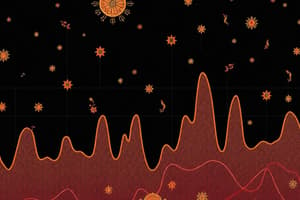Podcast
Questions and Answers
What is the primary purpose of a component bar diagram?
What is the primary purpose of a component bar diagram?
- To display data in a pie-chart format
- To represent the entire data set as a single unit
- To show data trends over time
- To compare different categories within a total (correct)
Which of the following is essential for constructing a pie-chart?
Which of the following is essential for constructing a pie-chart?
- Absolute values only
- Percentages for each category (correct)
- Angles for each sector (correct)
- Bar lengths corresponding to values
In the example provided regarding students from Urdu and English medium schools, what is the total number of students surveyed?
In the example provided regarding students from Urdu and English medium schools, what is the total number of students surveyed?
- 600
- 1800
- 1200 (correct)
- 1000
When calculating the angle for displaying a category in a pie-chart, which formula is used?
When calculating the angle for displaying a category in a pie-chart, which formula is used?
Which characteristic best describes a pie-chart?
Which characteristic best describes a pie-chart?
How many students are instructed in English according to the pie chart?
How many students are instructed in English according to the pie chart?
What is the total expenditure in the family based on the data provided?
What is the total expenditure in the family based on the data provided?
Which day had the highest number of net users according to the data?
Which day had the highest number of net users according to the data?
What is the cumulative frequency count for the upper limit interval of 69.5 to 79.5?
What is the cumulative frequency count for the upper limit interval of 69.5 to 79.5?
Which expenditure category accounts for the least amount?
Which expenditure category accounts for the least amount?
What percentage of students are instructed in Urdu?
What percentage of students are instructed in Urdu?
Which server had the least number of users on average over the week?
Which server had the least number of users on average over the week?
What percentage of students are from Urdu medium schools?
What percentage of students are from Urdu medium schools?
How do you determine the angle for a sector in a pie chart based on frequency data?
How do you determine the angle for a sector in a pie chart based on frequency data?
From the frequency data, how many counts reach up to the lower limit of 59.5?
From the frequency data, how many counts reach up to the lower limit of 59.5?
Which medium of instruction has a larger representation in the data?
Which medium of instruction has a larger representation in the data?
What is the total number of students surveyed in the data?
What is the total number of students surveyed in the data?
In constructing a pie chart, how are the sectors attributed to each medium of instruction?
In constructing a pie chart, how are the sectors attributed to each medium of instruction?
What is the main benefit of representing data in graphs rather than tables?
What is the main benefit of representing data in graphs rather than tables?
What type of graphical representation is most commonly used for numerical data frequency distribution?
What type of graphical representation is most commonly used for numerical data frequency distribution?
Which of the following is NOT a type of graphical representation for grouped data?
Which of the following is NOT a type of graphical representation for grouped data?
How are the widths of the bars in a histogram determined?
How are the widths of the bars in a histogram determined?
What do frequency polygons connect?
What do frequency polygons connect?
Which of the following statements about OGIVE curves is true?
Which of the following statements about OGIVE curves is true?
What is a characteristic of a simple bar diagram?
What is a characteristic of a simple bar diagram?
What differentiates a component bar diagram from a regular bar diagram?
What differentiates a component bar diagram from a regular bar diagram?
What is indicated by the height of bars in a histogram?
What is indicated by the height of bars in a histogram?
Which graphical representation is best suited for comparing different categories at the same point in time?
Which graphical representation is best suited for comparing different categories at the same point in time?
When constructing a frequency polygon, how is it derived from a histogram?
When constructing a frequency polygon, how is it derived from a histogram?
In a cumulative frequency distribution, what does the 'less than' curve represent?
In a cumulative frequency distribution, what does the 'less than' curve represent?
What type of bar chart uses different shades to represent multiple characteristics?
What type of bar chart uses different shades to represent multiple characteristics?
Flashcards are hidden until you start studying
Study Notes
Graphical Representation of Data
- Graphs and diagrams simplify complex data.
- Tables, while informative, aren't always the best for data presentation.
- Data representation methods are categorized into grouped and ungrouped data.
Types of Graphical Representation: Grouped Data
- Histogram: Uses adjacent bars; bar width represents class width, height represents frequency/relative frequency. Shows grouped data with class boundaries on the x-axis, frequencies on the y-axis.
- Frequency Polygon: Line graph connecting class marks and frequencies; can be derived from a histogram by joining bar midpoints. Shows continuous frequency distribution.
- Cumulative Frequency Polygon (OGIVE): Two types ("less than" and "more than"); line graphs showing upper/lower class boundaries and cumulative frequencies.
Types of Graphical Representation: Ungrouped Data
- Bar Chart: Uses bars of equal width; length is proportional to the values.
- Simple Bar Chart: Compares single characteristics.
- Multiple Bar Chart: Compares two or more characteristics for the same variable. Bars are grouped and shaded differently for identification.
- Component Bar Chart: Bars are divided into sections representing component parts; sections are differently shaded for easy recognition.
- Pie Chart (Sector Diagram): A circle divided into sectors; each sector’s area is proportional to its share of the whole quantity. Used to illustrate proportions. Angle of each sector is calculates as (share/total)*360 degrees.
Histogram Example
- Sample data: 12, 13, 17, 21, 24, 24, 26, 27, 27, 30, 32, 35, 37, 38, 41, 43, 44, 46, 53, 58
- Classes are created with defined boundaries (e.g., 10-19, 20-29 etc.) and the corresponding frequencies are calculated.
- A histogram plots these frequencies against the class boundaries. No gaps between bars due to continuous data.
Cumulative Frequency Polygon (OGIVE) Example
- Sample data includes class boundaries and frequencies.
- "Less than" cumulative frequency: A graph plotting upper class boundaries and their cumulative frequencies.
- "More than" cumulative frequency: A graph plotting lower class boundaries and their cumulative frequencies.
Pie Chart Example
-
To construct a pie chart:
- Calculate the percentage of each category: (category value / total value) * 100.
- Calculate the angle for each sector: (category value / total value) * 360.
-
Example: Survey of 1200 first-year students; 719 from Urdu medium schools, 481 from English medium schools. Urdu medium students constitute 60% (719/1200 * 100), English 40%. The pie chart would show sectors of 216 degrees (60% of 360) and 144 degrees (40% of 360).
Assignment Questions
- Create a pie chart representing family expenditures across various items (food, clothing, etc.).
- Draw a component bar diagram comparing daily net users across multiple servers.
- Draw a histogram, frequency polygon, and cumulative frequency polygon using provided cumulative count data.
Studying That Suits You
Use AI to generate personalized quizzes and flashcards to suit your learning preferences.



